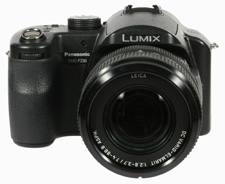Panasonic DMC-FZ30 review
-
-
Written by Gordon Laing
The Panasonic DMC-FZ30 is without a doubt a very classy all-in-one camera. Its massive zoom range simply beats rivals into submission, while the optical stabilisation really works a treat. Despite its low price, the FZ30’s build quality is also of a higher standard than the competition.

So how does it compare against specific models such as its closest rival, the Fujifilm S9500 / S9000 which costs virtually the same price. In its favour, the FZ30 has a more powerful telephoto, optical stabilisation, better build quality and a larger screen which flips and twists in every direction. On the other hand the Fujifilm has a wider angle lens and much higher sensitivity. In terms of image quality, our Results page shows each camera taking the lead in certain respects but coming out very similar overall.
So the choice between them is tough, and mostly boils down to the lens range and the kind of photography you’re into. Most obviously if you’re into wide angle shots, the Fujifilm’s 28mm is much better than the Panasonic’s 35mm. Conversely if you’re into zooming-in as close as possible, the Panasonic’s 420mm is much longer than the Fujifilm’s 300mm. Check our Features page to see these ranges in practice. Note if you’re really into wide angles, the 24mm of Sony’s R1 could trump them all.
Going further are each manufacturer’s approach to camera shake. At first glance the optical stabilisation of the FZ30 seems superior, eliminating camera-shake without compromising image quality. On the other hand though, the higher sensitivity of the S9500 / S9000 allows it to both counteract wobbles and freeze any motion which could otherwise appear blurred on the Panasonic – albeit at the cost of higher noise levels. Both approaches are illustrated on our Features page, and again it’s a case of swings and roundabouts.
If we had to make a choice between them though, the optical stabilisation, larger fully-flippable screen and superior build of the FZ30 gives it the edge over the S9500 / S9000, although as discussed, the Fujifilm’s wider angle and higher sensitivity could make it a better choice depending on your style of photography.
As for the FZ30 versus a budget Digital SLR, there’s quite a price difference between it and even the cheapest model. But if you’re considering the next step-up, a Digital SLR should deliver lower noise levels, faster handling, better manual focusing and of course the ability to swap lenses.
The downside to a Digital SLR compared to the FZ30 is a much shorter zoom range as part of a standard bundle, no movie mode nor the ability to compose using a flip-out screen, and the risk of dust getting on the sensor when you change lenses. Only you can weigh these pros and cons up for yourself.
If you decide and all-in-one camera is better for you than a Digital SLR, the Panasonic DMC-FZ30 is a great choice. It boasts a massive optically-stabilised zoom, fully-flippable screen, great build quality and decent images.
That said, anyone considering the FZ30 should closely compare it with Fujifilm’s S9500 / S9000 and also Sony’s R1. Each has unique pros and cons which could sway your ultimate decision. Should you decide on the FZ30 though you won’t be disappointed. It’s an excellent camera and comes Highly Recommended.
Please visit our Super-zoom digital camera Buyer’s Guide for an update of the best buys around right now.
UPDATE: See how the FZ30’s successor compares in our Panasonic Lumix FZ50 review and video tour




